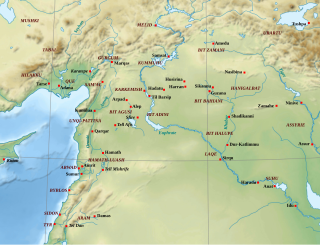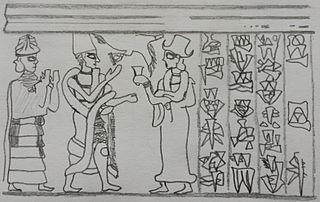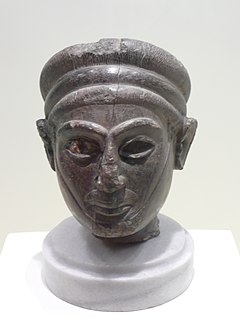Irridu (Irrite) was a city in northwestern Mesopotamia, likely located between Harran and Carchemish. It flourished in the middle and late Bronze Age before being destroyed by Assyria.
The city was first mentioned in a letter from the king of Carchemish to Zimri-Lim of Mari. The letter suggested that Irridu had been a subject of Carchemish, and subsequently it came under the rule of Yamhad. [1]
In the middle of the 18th century BC, the city was ruled by Yarim-Lim, who was the brother of Abba-El I, king of Yamhad. Zitraddu, the governor of the city, rebelled against Yarim-Lim; Abba-El I quashed the rebels violently to the extent of destroying the city and he compensated his brother by giving him Alalakh. [2]
After the fall of Aleppo, the capital of Yamhad, to the Hittite king Mursili I, Irridu came under the control of Mittani. The Hittites, under prince Piyassili, [3] occupied Irridu in their advance upon the Mittanian capital Washukanni and after the Hittites retreated, it became a regional center for Mittani until it was conquered by Adad-nirari I, king of Assyria.
King Wasashatta of Mittani rebelled against the Assyrians and sought the help of the Hittites, but received none. Adad-nirari I attacked Mittani and conquered most of its cities. The royal family of Mittani escaped to Irridu but the Assyrians found them and deported them to Assyria.
Irridu and many cities in its area were set on fire, destroyed, and sowed with salty plants. [4]

Shalmaneser I was a king of Assyria during the Middle Assyrian Empire. Son of Adad-nirari I, he succeeded his father as king in 1265 BC.

Mitanni, also called Hanigalbat or Hani-Rabbat in Assyrian or Naharin in Egyptian texts, was a Hurrian-speaking state in northern Syria and southeast Anatolia.

Yamhad was an ancient Semitic kingdom centered on Ḥalab (Aleppo), Syria. The kingdom emerged at the end of the 19th century BC, and was ruled by the Yamhadite dynasty kings, who counted on both military and diplomacy to expand their realm. From the beginning of its establishment, the kingdom withstood the aggressions of its neighbors Mari, Qatna and Assyria, and was turned into the most powerful Syrian kingdom of its era through the actions of its king Yarim-Lim I. By the middle of the 18th century BC, most of Syria minus the south came under the authority of Yamhad, either as a direct possession or through vassalage, and for nearly a century and a half, Yamhad dominated northern, northwestern and eastern Syria, and had influence over small kingdoms in Mesopotamia at the borders of Elam. The kingdom was eventually destroyed by the Hittites, then annexed by Mitanni in the 16th century BC.

Qatna was an ancient city located in Homs Governorate, Syria. Its remains constitute a tell situated about 18 km (11 mi) northeast of Homs near the village of al-Mishrifeh. The city was an important center through most of the second millennium BC and in the first half of the first millennium BC. It contained one of the largest royal palaces of Bronze Age Syria and an intact royal tomb that has provided a great amount of archaeological evidence on the funerary habits of that period.
Adad-nirari II is generally considered to be the first King of Assyria in the Neo-Assyrian period.
Adad-nārārī I, rendered in all but two inscriptions ideographically as mdadad-ZAB+DAḪ, meaning “Adad (is) my helper,” was a king of Assyria during the Middle Assyrian Empire. He is the earliest Assyrian king whose annals survive in any detail. Adad-nārārī I achieved major military victories that further strengthened Assyria. In his inscriptions from Assur he calls himself son of Arik-den-ili, the same filiations being recorded in the Nassouhi kinglist. He is recorded as a son of Enlil-nirari in the Khorsabad kinglist and the SDAS kinglist, probably in error.

Bit Adini, a city or region of Syria, called sometimes Bit Adini in Assyrian sources, was an Aramaean state that existed as an independent kingdom during the 10th and 9th centuries BC, with its capital at Til Barsib. The city is considered one of the two chief states of the Aramean-held territories in the Euphrates along with Carchemish.
During the Middle Assyrian Empire and the Neo-Assyrian Empire, Phoenicia, what is today known as Lebanon and coastal Syria, came under Assyrian rule on several occasions.

The Neo-Assyrian Empire was an Iron Age Mesopotamian empire, in existence between 911 and 609 BC, and became the largest empire of the world up until that time. The Assyrians perfected early techniques of imperial rule, many of which became standard in later empires. The Assyrians were the first to be armed with iron weapons, and their troops employed advanced, effective military tactics.

The Middle Assyrian Empire is the period in the history of Assyria between the fall of the Old Assyrian Empire in the 14th century BC and the establishment of the Neo-Assyrian Empire in the 10th century BC.
Yarim-Lim I, also given as Yarimlim, was the second king of the ancient Amorite kingdom of Yamhad in modern-day Aleppo, Syria.
Sumu-Epuh is the first attested king of Yamhad (Halab). He founded the Yamhad dynasty which controlled northern Syria throughout the 17th and 18th centuries BC.

Abba-El I was the king of Yamhad (Halab), succeeding his father Hammurabi I.
Yarim-Lim III was the king of Yamhad (Halab) succeeding Hammurabi II.
Urshu, Warsuwa or Urshum was a Hurrian-Amorite city-state in southern Turkey, probably located on the west bank of the Euphrates, and north of Carchemish.
Hassum was a Hurrian city-state, located in southern Turkey most probably on the Euphrates river north of Carchemish.

Yarim-Lim was a king of Alalakh and son of Hammurabi I of Yamhad. He was granted the city of Alalakh by his brother Abba-El I of Yamhad and started a cadet branch of the Yamhadite dynasty that lasted until the conquest of Alalakh by the Hittite king Hattusili I.

The Yamhad dynasty was an ancient Amorite royal family founded in c. 1810 BC by Sumu-Epuh of Yamhad who had his capital in the city of Aleppo. Started as a local dynasty, the family expanded its influence through the actions of its energetic ruler Yarim-Lim I who turned it into the most influential family in the Levant through both diplomatic and military tools. At its height the dynasty controlled most of northern Syria and the modern Turkish province of Hatay with a cadet branch ruling in the city of Alalakh.

The timeline of the Assyrian Empire